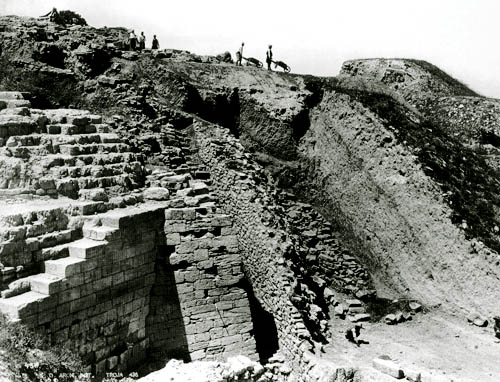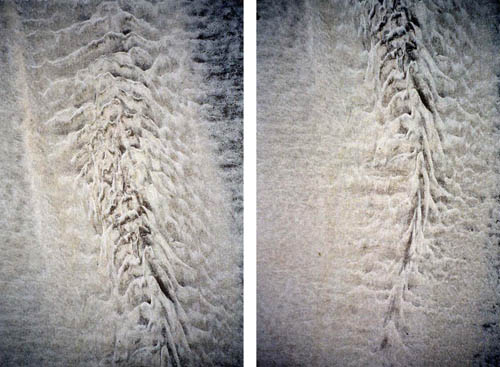Agamemnon's Fortress
In his recent book The Lost Books of the Odyssey—an "ingeniously Borgesian novel that’s witty, playful, moving and tirelessly inventive"—author Zachary Mason, an Artificial Intelligence researcher, fictionalizes King Agamemnon's attempts to build a fortress underground.
 [Image: The walls of Troy slowly revealed].
[Image: The walls of Troy slowly revealed].
Agamemnon's choice of site, however, makes this task rather difficult: it is to be constructed in the sandy plains facing the walls of Troy.
 [Images: Extraordinary photographs of sand by Larry Deemer].
[Images: Extraordinary photographs of sand by Larry Deemer].
The architectural nature of sand grains is something discussed by Michael Welland in his own book Sand. There, Welland introduces us to the complex internal structures of sand dunes:
Agamemnon's fortress is thus a mathematical model of collapse—an inhabitable diagram of the forces traveling through it—bulwarked and avalanching against itself into new formations and plans. It is an architecture of dynamic materials.
 [Image: The walls of Troy slowly revealed].
[Image: The walls of Troy slowly revealed].Agamemnon's choice of site, however, makes this task rather difficult: it is to be constructed in the sandy plains facing the walls of Troy.
- Agamemnon wanted a fortress on the wide plain before the walls of Troy but there was nothing to build with but a few trees and an unlimited quantity of sand. Therefore (at Odysseus's suggestion) the Greeks dug the negative image of a palace in the white plain, a convoluted warren where cascades of fine grains trickled endlessly down the walls and into the tenuous corridors irregularly shored up with masonry.
- Following the wisdom of the court geomancers it was considered impious to exhume any of the collapsed rooms and tunnels, a sin on par with looting a tomb, so when more space was needed the miners struck out into virgin ground. Thus the new underground palace evolved dendritically, sending off new shoots in all directions, sometimes opposed by unforeseen aquifers or plumes of hard rock, working around these obstacles with ant-like tenacity.
 [Images: Extraordinary photographs of sand by Larry Deemer].
[Images: Extraordinary photographs of sand by Larry Deemer].The architectural nature of sand grains is something discussed by Michael Welland in his own book Sand. There, Welland introduces us to the complex internal structures of sand dunes:
- The weight and pressure distribution within a pile of any granular material is determined by the way in which the individual grains contact each other and distribute the stress. Quite commonly, grain shapes and sizes mean that there are microscopic chains and networks of grains that are oriented and in contact with each other in such a way that they carry most of the pressure from the weight of the material above them. These chains seem to behave like the soaring arches of Gothic cathedrals, which serve to transmit the weight of the roof, perhaps a great dome, outward to the walls, which bear the load. In a sand pile, particularly one that is confined in a container of some sort, these chains perform the same function—they carry the stress outward to the container, rather than directly downward to the base of the pile.
Agamemnon's fortress is thus a mathematical model of collapse—an inhabitable diagram of the forces traveling through it—bulwarked and avalanching against itself into new formations and plans. It is an architecture of dynamic materials.





Comments are moderated.
If it's not spam, it will appear here shortly!
I bet King Agamemnon wishes he had thought of this....
http://www.ted.com/talks/lang/eng/magnus_larsson_turning_dunes_into_architecture.html
JD, I love Larsson's project, and wrote about it last year. Great stuff.
Post a Comment